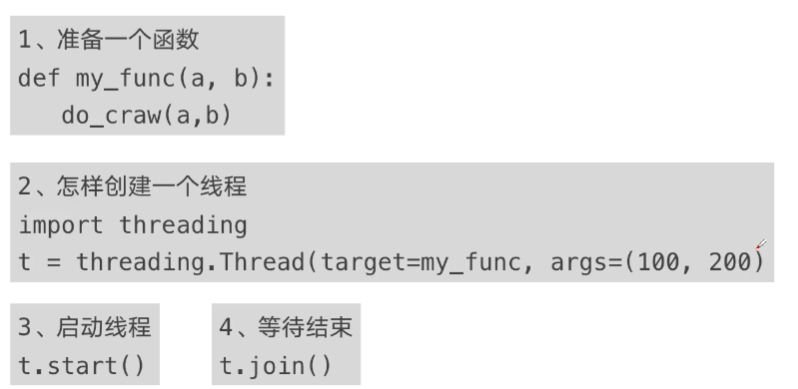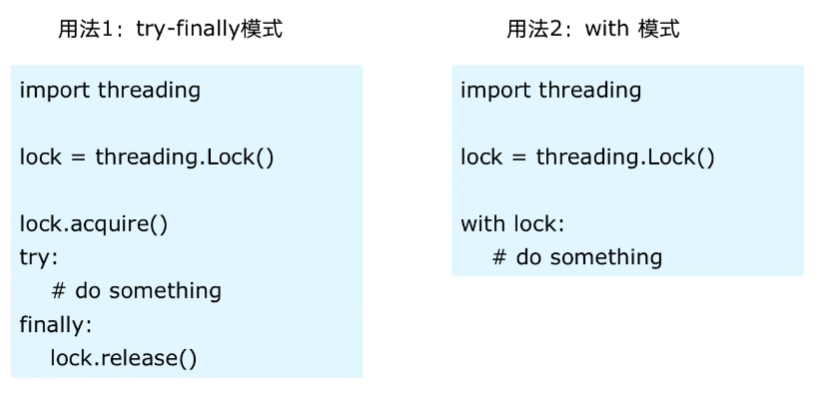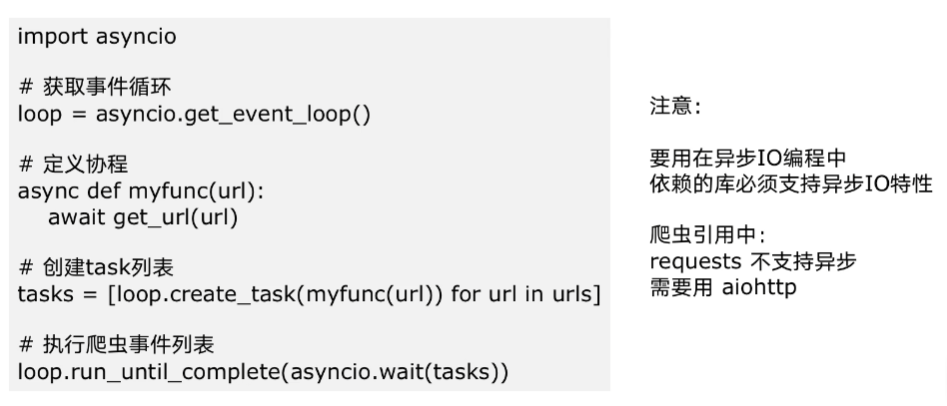并发编程
并发编程
程序提速方法
- 单线程串行
- 多线程并发
- 多 CPU 并行
- 多机器并行

python 对并发编程的支持
- 多线程:threading,利用CPU和IO可以同时执行的原理,让CPU不会干巴巴等待IO完成
- 多进程:multiprocessing,利用多核CPU的能力,真正的并行执行任务
- 异步IO:asyncio,在单线程利用CPU和IO同时执行的原理,实现函数异步执行
- 使用Lock对资源加锁,防止冲突访问
- 使用Queue实现不同线程/进程之间的数据通信,实现生产者-消费者模式
- 使用线程池Pool/进程池Pool,简化线程/进程的任务提交、等待结束、获取结果
- 使用subprocess启动外部程序的进程,并进行输入输出交互
多线程Thread、多进程Process、多协程Coroutine
CPU密集型计算、IO密集型计算
CPU密集型(CPU-bound):也叫计算密集型,简单来说就是程序中需要CPU进行大量的计算和处理,而I/O在很短时间内就能完成。特点是CPU占用率相当高。
如:压缩解压缩、加密解密、正则表达式搜索、
IO密集型(I/O bound):指程序运行中,大部分情况都是CPU等待IO(硬盘/内存)的读写操作,CPU占用率很低。
如:文件处理程序、网络爬虫程序、读写数据库程序
多线程、多进程、多协程的比较
多线程:
- 优点:可以利用多核CPU并行运算
- 缺点:占用资源最多、可启动数目比线程少
- 适合:CPU密集型计算
多进程:
- 优点:相比进程,更轻量、占用资源少
- 缺点:
- 相比进程:多线程只能并发执行,不能利用多CPU(GIL)
- 相比协程:启动数目有限制,占用内存资源,有线程切换开销
- 适合:IO密集型计算、同时运行的任务数目要求不多
多协程:
- 优点:内存开销最少、启动协程数量最多
- 缺点:支持的库有限制(aiohttp vs requests)、代码实现复杂
- 适合:IO密集型计算、需要超多任务运行、但有线程库支持的场景
一个进程中可以启动多个线程,一个线程中可以启动多个协程
创建多线程的方法

简单比较单线程和多线程的速度
创建爬取内容的文件
# cnblog_spider.py
import requests
urls = [
f"https://www.cnblogs.com#p{page}"
for page in range(1, 51)
]
def craw(url):
r = requests.get(url)
print(url, len(r.text))
单线程:
from cnblog_spider import urls, craw import threading import time # 单线程爬取 def single_thread(): print("single_thread start") for url in urls: craw(url) print("single_thread end") if __name__ == "__main__": start = time.time() single_thread() end = time.time() print(f"sigle time: {end - start}") pass用时如下:

多线程
from cnblog_spider import urls, craw import threading import time # 多线程爬取 def multi_thread(): print("multi_thread start") threads = [] for url in urls: # 创建多线程 threads.append( # 因为这个 args 是个元组,所以这里加了个逗号 threading.Thread(target=craw, args=(url,)) ) # 开启多线程 for thread in threads: thread.start() # 等待多线程结束 for thread in threads: thread.join() print("multi_thread end") if __name__ == "__main__": start = time.time() multi_thread() end = time.time() print(f"multi time: {end - start}") pass用时如下:

可以看到,多线程比单线程用时快了
8.29 / 0.28 = 29.6倍。测试时使用的CPU为:i5-12400f
实现生产者-消费者模式爬虫架构
多组件的Pipeline技术架构
复杂的事情不会一步到位,一般会有很多的中间步骤,用以降低整体的复杂度。
下面这个流程就叫Pipeline,其中的每个处理器就叫Processor:

上面这个流程中,处理器1就是生产者,它的作用是获取输入数据,然后生成结果给下一个处理器。最后一个处理器就是消费者,它的作用是获取中间数据,生成输出数据返回。
生产者-消费者爬虫架构

简单说就是:生产者通过读取待爬取的url列表,将内容下载下来,然后将下载好的网页队列给到中间处理器进行解析,最后将所有的解析结果给到消费者,它将这些内容存入文件或数据库。
多线程数据通信
queue.Queue可以用于多线程之间的、线程安全的数据通信。

q.put()会阻塞主线程,即当q已经满了的情况下,它不会向其中put内容,直到有一个数据被取出,空出空间后才会继续put。
q.get()也会阻塞主线程,即当q中没有数据时,它会卡住,直到q中有内容能获取,才会继续get。
生产者-消费者爬虫简单实例
爬虫程序
# cnblog_spider.py
import requests
from bs4 import BeautifulSoup
urls = [
f"https://www.cnblogs.com#p{page}"
for page in range(1, 51)
]
def craw(url):
r = requests.get(url)
# print(url, len(r.text))
return r.text
def parse(html):
soup = BeautifulSoup(html, "html.parser")
links = soup.find_all("a", attrs={"class": "post-item-title"})
return [(link["href"], link.get_text()) for link in links]
使用threading和queue实现生产者-消费者功能
import queue
from cnblog_spider import craw, parse, urls
import time
import random
import threading
# 生产者线程执行函数
def do_craw(url_queue: queue.Queue, html_queue: queue.Queue):
while True:
url = url_queue.get()
html = craw(url)
html_queue.put(html)
print(threading.current_thread().name, f"craw {url}", f"url_queue.size={url_queue.qsize()}")
time.sleep(random.randint(1, 2))
# 消费者线程执行函数
def do_parse(html_queue: queue.Queue, fout):
# fout 是写入内容的文件
while True:
html = html_queue.get()
res = parse(html)
for result in res:
fout.write(str(result) + "\n")
print(threading.current_thread().name, f"res.size {len(res)}", f"html_queue.size={html_queue.qsize()}")
time.sleep(random.randint(1, 2))
if __name__ == "__main__":
# 创建 url 队列和 html 队列
url_queue = queue.Queue()
html_queue = queue.Queue()
# 向 url 队列存入 url 数据
for url in urls:
url_queue.put(url)
# 生产者线程
for idx in range(3):
t = threading.Thread(target=do_craw, args=(url_queue, html_queue), name=f"craw{idx}")
t.start()
# 消费者线程
fout = open("producer_consumer_spider.txt", "w")
for idx in range(2):
t = threading.Thread(target=do_parse, args=(html_queue, fout), name=f"parse{idx}")
t.start()
python 线程安全问题和解决方案
线程安全
线程安全指某个函数、函数库在多线程环境中被调用时,能够正确地处理多个线程之间的共享变量,使程序功能正确完成。
由于线程的执行随时会发生切换,就造成了不可预料的结果,出现线程不安全。
如一个 if 判断,在第一个线程中进入了 if,而还没执行 if 中的语句,第二个线程也进入了 if(但是实际想要的情况是第一个线程的 if 执行了后,第二个线程的 if 条件就不满足了,无法进入),这样就会导致出现错误。
Lock 用于解决线程安全问题

没有加锁的情况
import threading from time import sleep class Account: def __init__(self, balance) -> None: self.balance = balance def draw(account, amount): if account.balance >= amount: # sleep 会导致线程的阻塞,从而切换线程 sleep(0.1) print(threading.current_thread().name, "取钱成功") account.balance -= amount print(threading.current_thread().name, f"余额:{account.balance}") else: print(threading.current_thread().name, "取钱失败,余额不足") if __name__ == "__main__": account = Account(1000) # 创建两个线程 ta = threading.Thread(name="ta", target=draw, args=(account, 800)) tb = threading.Thread(name="tb", target=draw, args=(account, 800)) ta.start() tb.start()
加锁的情况
import threading from time import sleep # 实例化线程锁 lock = threading.Lock() class Account: def __init__(self, balance) -> None: self.balance = balance def draw(account, amount): # 添加线程锁 with lock: if account.balance >= amount: # sleep 会导致线程的阻塞,从而切换线程 sleep(0.1) print(threading.current_thread().name, "取钱成功") account.balance -= amount print(threading.current_thread().name, f"余额:{account.balance}") else: print(threading.current_thread().name, "取钱失败,余额不足") if __name__ == "__main__": account = Account(1000) # 启动两个线程 ta = threading.Thread(name="ta", target=draw, args=(account, 800)) tb = threading.Thread(name="tb", target=draw, args=(account, 800)) ta.start() tb.start()
python好用的线程池ThreadPoolExecutor
线程池的原理

上图是线程的生命周期图。
因为程序中可能会有很多的线程,因此每次新建线程时,就需要分配资源,每次终止线程时,就需要回收资源。这样新建和终止都有一些时间开销,如果一个线程我们可以拿来重用,则可以去除新建和终止的时间开销了,这就是线程池基于的原理。

使用线程池的好处
- 提升性能:因为去掉了大量新建、终止线程的开销,重用了线程资源;
- 适用场景:适合处理突发性大量请求或需要大量线程完成任务、但实际任务处理时间较短;
- 防御功能:能有效避免系统因为创建线程过多,而导致系统负荷过大相应变慢等问题;
- 代码优势:使用线程池的语法比自己新建线程执行线程更加简洁。
ThreadPoolExecutor的使用语法

使用线程池的代码:
import concurrent.futures
# 从前面的爬虫程序中导入方法和变量
from cnblog_spider import craw, parse, urls
# craw
with concurrent.futures.ThreadPoolExecutor() as pool:
# urls 是一个列表
htmls = pool.map(craw, urls)
htmls = list(zip(urls, htmls))
for url, html in htmls:
print(url, len(html))
print("craw over")
# parse
with concurrent.futures.ThreadPoolExecutor() as pool:
futures = {}
for url, html in htmls:
future = pool.submit(parse, html)
futures[future] = url
# 按顺序执行和输出
for future, url in futures.items():
print(url, future.result())
# 谁先执行完,谁先输出,乱序的
for future in concurrent.futures.as_completed(futures):
url = futures[future]
print(url, future.result())
在 Web 服务中使用线程池实现加速
from fastapi import FastAPI
import uvicorn
from concurrent.futures import ThreadPoolExecutor
from time import sleep
app = FastAPI()
pool = ThreadPoolExecutor()
def read_file():
sleep(0.1)
return "file done"
def read_db():
sleep(0.2)
return "db done"
def read_api():
sleep(0.3)
return "api done"
@app.get("/")
def root():
# 不使用线程池加速的情况下,这三个任务总耗时为三个任务之和,即大概 600ms
# 使用线程池加速的情况下,这三个任务总耗时为三个任务中耗时最长的任务,即大概300ms
res_file = pool.submit(read_file)
res_db = pool.submit(read_db)
res_api = pool.submit(read_api)
return {
"res_file": res_file.result(),
"res_db": res_db.result(),
"res_api": res_api.result(),
}
if __name__ == "__main__":
uvicorn.run(
app="web_thread_pool:app",
host="127.0.0.1",
port=8000,
reload=True
)
使用多进程 multiprocessing 模块加速程序
为什么有了多线程,还要使用多进程

上图中的每个 check,都会增加性能损耗,导致减慢运行速度,因此需要多进程。
多进程知识梳理
多进程知识对比多线程,我们会发现除了类名之外,其他使用方式几乎一样:

在 web 服务中使用多进程加速
这跟使用多线程类似,但是有一个很关键的区别:多进程创建进程池的代码必须写在 main 中(如果使用的是flask框架,我测试fastapi框架时没有问题),如下:
import flask
from concurrent.futures import ProcessPoolExecutor
app = flask.Flask(__name__)
# 如果写在这里会报错
# pool = ProcessPoolExecutor()
# ... 这里省略其他业务代码
if __name__ == "__main__":
# 写在这里就可以正常运行
pool = ProcessPoolExecutor()
app.run()
异步IO实现并发爬虫
协程:在单线程中实现并发
核心原理:用一个超级循环,即 while True,配合IO多路复用原理(IO执行时,CPU可以执行其他任务)

异步IO库:asyncio

异步IO爬虫示例:
import asyncio
# 因为 requests 不支持 asyncio,因此需要 aiohttp 这个库
import aiohttp
import time
async def async_craw(url):
print(f"craw url: {url}")
async with aiohttp.ClientSession() as session:
async with session.get(url) as resp:
# 这里的 await 等待时,会触发下一个任务的执行
result = await resp.text()
print(f"craw url: {url}, {len(result)}")
loop = asyncio.get_event_loop()
# url列表:包含所有要爬取的页面
urls = [
f"https://www.cnblogs.com#p{page}"
for page in range(1, 51)
]
# 任务列表:给每个网页的爬取都创建一个任务
tasks = [
loop.create_task(async_craw(url))
for url in urls
]
start = time.time()
# 执行任务,直到全部完成
loop.run_until_complete(asyncio.wait(tasks))
end = time.time()
print(f"time is: {end - start}")

使用信号量控制异步IO的并发量

上面的代码的改造:
import asyncio
import aiohttp
import time
async def async_craw(url):
# 控制并发量
async with sem:
print(f"craw url: {url}")
async with aiohttp.ClientSession() as session:
async with session.get(url) as resp:
result = await resp.text()
print(f"craw url: {url}, {len(result)}")
loop = asyncio.get_event_loop()
# 控制并发量
sem = asyncio.Semaphore(10)
urls = [
f"https://www.cnblogs.com#p{page}"
for page in range(1, 51)
]
tasks = [
loop.create_task(async_craw(url))
for url in urls
]
start = time.time()
loop.run_until_complete(asyncio.wait(tasks))
end = time.time()
print(f"time is: {end - start}")
